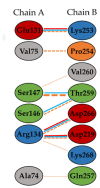Autoxidation Products of the Methanolic Extract of the Leaves of Combretum micranthum Exert Antiviral Activity against Tomato Brown Rugose Fruit Virus (ToBRFV)
- PMID: 35164024
- PMCID: PMC8838289
- DOI: 10.3390/molecules27030760
Autoxidation Products of the Methanolic Extract of the Leaves of Combretum micranthum Exert Antiviral Activity against Tomato Brown Rugose Fruit Virus (ToBRFV)
Abstract
Tomato brown rugose fruit virus (ToBRFV) is a new damaging plant virus of great interest from both an economical and research point of view. ToBRFV is transmitted by contact, remains infective for months, and to-date, no resistant cultivars have been developed. Due to the relevance of this virus, new effective, sustainable, and operator-safe antiviral agents are needed. Thus, 4-hydroxybenzoic acid was identified as the main product of the alkaline autoxidation at high temperature of the methanolic extract of the leaves of C. micranthum, known for antiviral activity. The autoxidized extract and 4-hydroxybenzoic acid were assayed in in vitro experiments, in combination with a mechanical inoculation test of tomato plants. Catechinic acid, a common product of rearrangement of catechins in hot alkaline solution, was also tested. Degradation of the viral particles, evidenced by the absence of detectable ToBRFV RNA and the loss of virus infectivity, as a possible consequence of disassembly of the virus coat protein (CP), were shown. Homology modeling was then applied to prepare the protein model of ToBRFV CP, and its structure was optimized. Molecular docking simulation showed the interactions of the two compounds, with the amino acid residues responsible for CP-CP interactions. Catechinic acid showed the best binding energy value in comparison with ribavirin, an anti-tobamovirus agent.
Keywords: 4-hydroxybenzoic acid; Combretum micranthum; ToBRFV; catechinic acid; coat protein; molecular docking.
Conflict of interest statement
The authors declare no conflict of interest.
Figures






References
-
- Pennazio S., Roggero P., Conti M. Yield losses in virus-infected crops. Arch. Phytopathol. Plant Prot. 1996;30:283–296. doi: 10.1080/03235409609383178. - DOI
-
- Chauhan P., Singla K., Rajbhar M., Singh A., Das N., Kumar K. A systematic review of conventional and advanced approaches for the control of plant viruses. J. Appl. Biol. Biotechnol. 2019;7:89–98. doi: 10.7324/JABB.2019.70414. - DOI
MeSH terms
Substances
Grants and funding
LinkOut - more resources
Full Text Sources
Miscellaneous

